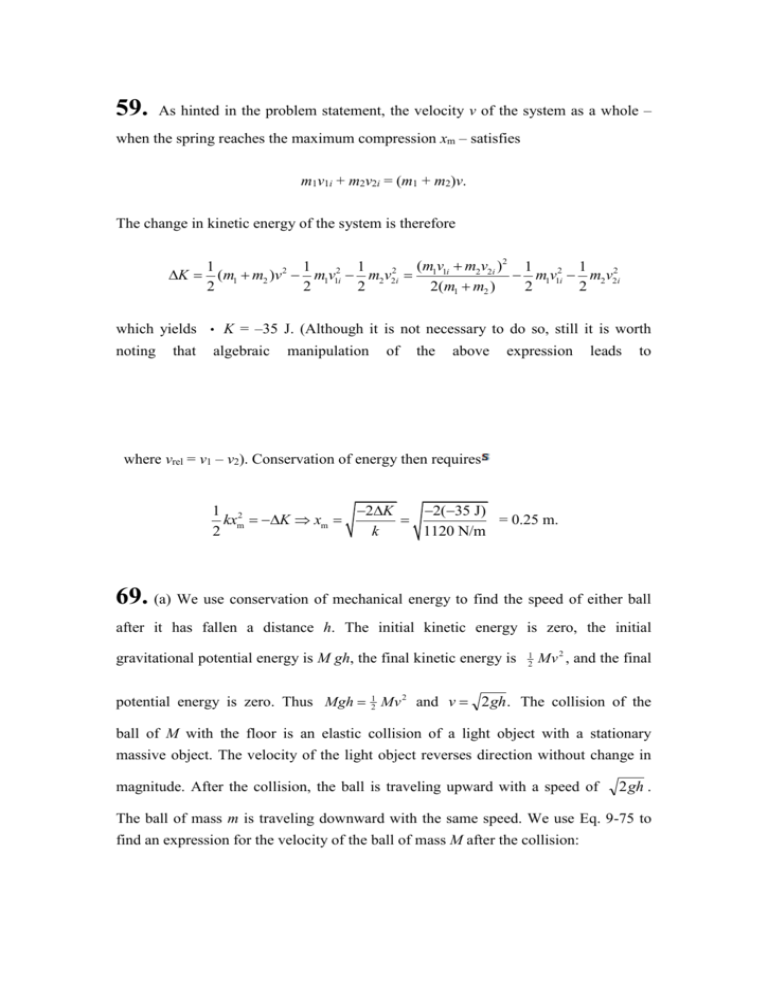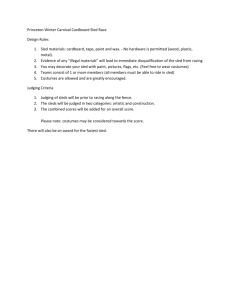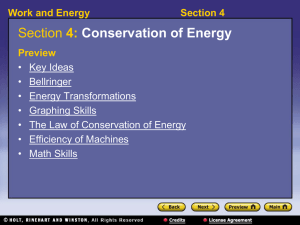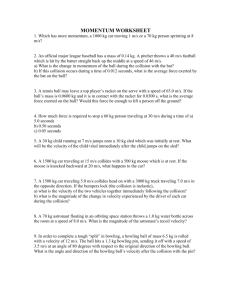ch9-1
advertisement

59. As hinted in the problem statement, the velocity v of the system as a whole – when the spring reaches the maximum compression xm – satisfies m1v1i + m2v2i = (m1 + m2)v. The change in kinetic energy of the system is therefore (m1v1i m2v2i )2 1 1 1 1 1 2 2 2 K (m1 m2 )v m1v1i m2v2i m1v12i m2v22i 2 2 2 2(m1 m2 ) 2 2 which yields noting that K = –35 J. (Although it is not necessary to do so, still it is worth algebraic manipulation of the above expression leads to where vrel = v1 – v2). Conservation of energy then requires 1 2 2K 2(35 J) = 0.25 m. kxm K xm 2 k 1120 N/m 69. (a) We use conservation of mechanical energy to find the speed of either ball after it has fallen a distance h. The initial kinetic energy is zero, the initial gravitational potential energy is M gh, the final kinetic energy is 1 2 Mv 2 , and the final potential energy is zero. Thus Mgh 21 Mv 2 and v 2 gh . The collision of the ball of M with the floor is an elastic collision of a light object with a stationary massive object. The velocity of the light object reverses direction without change in magnitude. After the collision, the ball is traveling upward with a speed of 2gh . The ball of mass m is traveling downward with the same speed. We use Eq. 9-75 to find an expression for the velocity of the ball of mass M after the collision: vMf M m 2m M m 2m M 3m vMi vmi 2 gh 2 gh 2 gh . M m M m M m M m M m For this to be zero, m = M/3. With M = 0.63 kg, we have m = 0.21 kg. (b) We use the same equation to find the velocity of the ball of mass m after the collision: vmf m M 2M 3M m 2 gh 2 gh 2 gh M m M m M m which becomes (upon substituting M = 3m) vmf 2 2 gh . We next use conservation of mechanical energy to find the height h' to which the ball rises. The initial kinetic energy is 1 2 mvm2 f , the initial potential energy is zero, the final kinetic energy is zero, and the final potential energy is mgh'. Thus, vm2 f 1 2 mvm f mgh' h' 4h . 2 2g With h = 1.8 m, we have h’ = 7.2 m. 80. (a) We use Eq. 9-68 twice: v2 = v3 = 2m1 v m1 + m2 1i 2m2 v m2 + m3 2 2m1 (4.00 m/s) = 1.5m1 = 2m2 (16/3 m/s) = 1.5m2 = 16 3 m/s 64 9 m/s = 7.11 m/s . (b) Clearly, the speed of block 3 is greater than the (initial) speed of block 1. (c) The kinetic energy of block 3 is K3f = 1 2 m3 v32 = 1 2 3 () m1 16 9 2 64 ( ) v 2 = 81 K 1i 1i . We see the kinetic energy of block 3 is less than the (initial) K of block 1. In the final situation, the initial K is being shared among the three blocks (which are all in motion), so this is not a surprising conclusion. (d) The momentum of block 3 is p3f = m3 v3 = 1 2 2 ( ) m (169)v 1 1i 4 = 9 p1i and is therefore less than the initial momentum (both of these being considered in magnitude, so questions about sign do not enter the discussion). 136. Let M = 22.7 kg and m = 3.63 be the mass of the sled and the cat, respectively. Using the principle of momentum conservation, the speed of the first sled after the cat’s first jump with a speed of vi 3.05 m/s is v1 f mvi 0.488 m/s . M On the other hand, as the cat lands on the second sled, it sticks to it and the system (sled plus cat) moves forward with a speed v2 f mvi 0.4205 m/s. M m When the cat makes the second jump back to the first sled with a speed vi, momentum conservation implies Mv2 ff mvi ( M m)v2 f mvi mvi 2mvi which yields v2 f f 2mvi 0.975 m/s. M After the cat lands on the first sled, the entire system (cat and the sled) again moves together. By momentum conservation, we have ( M m)v1 ff mvi Mv1 f mvi mvi 2mvi or v1 ff 2mvi 0.841 m/s. M m (a) From the above, we conclude that the first sled moves with a speed v1 ff 0.841 m/s a after the cat’s two jumps. (b) Similarly, the speed of the second sled is v2 f f 0.975 m/s.









![Agenda [PDF] - Kantar Retail iQ](http://s3.studylib.net/store/data/009224375_1-54a23f749c9b42b71d17c9eeecff87c7-300x300.png)